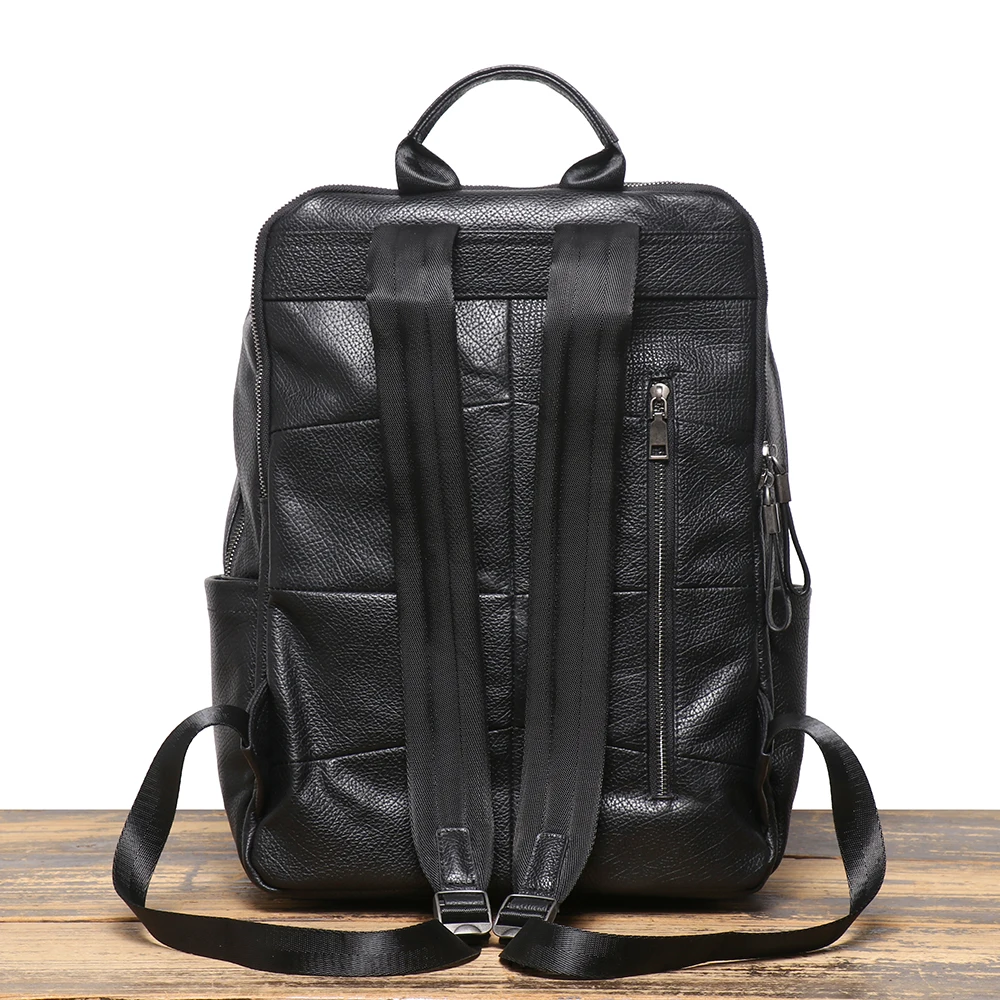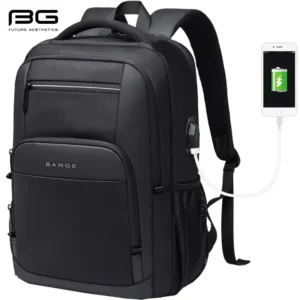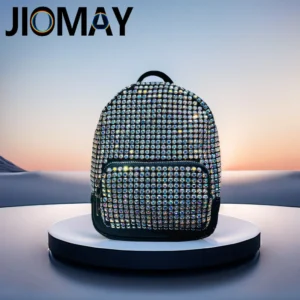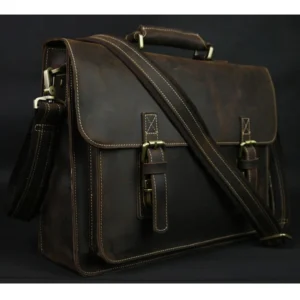Introduction: Understanding Leather Quality for Backpack Selection
When it comes to backpacks that stand the test of time, leather has been the gold standard for centuries. The type of leather used in a backpack isn’t just a matter of appearance—it fundamentally determines how long your bag will last, how it will age, and whether your investment will pay off over time.
Choosing the right leather for your backpack involves understanding a surprisingly complex hierarchy of quality and characteristics. Not all leather is created equal, and the differences between types can mean the difference between a bag that lasts decades and one that falls apart after a single season.
In this comprehensive guide, we’ll explore:
– The distinct types of leather used in backpacks (full-grain, top-grain, genuine, bonded, and synthetic options)
– How each leather type performs in real-world conditions
– Which leather offers the best value for your specific needs
– How to identify quality leather beyond marketing terminology
A quality leather backpack represents an investment in both function and style. Understanding the differences between full-grain and top-grain leather will equip you with the knowledge needed to make a choice you’ll be satisfied with for years to come.
The Leather Quality Hierarchy: What You Need to Know
Before diving into specific leather types, it’s important to understand how leather quality is structured. In the world of leather goods, there’s a clear hierarchy that correlates directly with durability, appearance, and price:
- Full-grain leather (highest quality)
- Top-grain leather
- Genuine leather
- Bonded leather
- Faux/synthetic leather alternatives
This hierarchy reflects how the animal hide is processed after tanning. Leather begins as a complete hide that can be split horizontally into layers. The uppermost layer, which contained the animal’s hair, has the tightest fiber structure and is the strongest part of the hide.
One of the most common misconceptions in leather shopping is the term “genuine leather.” Despite sounding like a mark of authenticity, it’s actually a specific grade of leather—and not a particularly high one. Understanding the four grades of leather quality helps you see through marketing terminology to identify true value.
The natural grain pattern visible in higher-quality leathers isn’t just about appearance—it’s a testament to structural integrity. This pattern indicates that the natural fiber structure remains intact, providing remarkable durability. When properly cared for, full-grain leather items can last decades, while lower grades might deteriorate within months or a few years.
This knowledge forms the foundation for evaluating any leather backpack, regardless of price point or brand claims.
Full-Grain Leather: The Ultimate Choice for Durability
Full-grain leather represents the pinnacle of leather quality, consisting of the outermost layer of the hide with its natural grain completely intact. This untouched surface contains the densest fiber structure, making it exceptionally strong and durable.
Distinctive Characteristics:
- Natural markings, including minor scars and growth lines that show the leather’s authenticity
- Visible pore structure that allows the material to breathe
- Tight, dense fibers that resist tearing and stretching
- A surface that develops a beautiful patina (character) over time
Advantages for Backpacks:
- Exceptional durability, often lasting 15-20+ years with proper care
- Natural water resistance (though not waterproof without treatment)
- Develops a rich, personalized patina that improves with age
- Outstanding breathability that prevents moisture buildup inside
- Ages gracefully, often looking better after years of use
Limitations:
- Higher initial investment ($200-400 range for quality backpacks)
- Requires a break-in period before reaching maximum comfort
- Typically heavier than other options (3-5 pounds for a medium backpack)
- Requires consistent (though simple) maintenance to maintain optimal condition
Full-grain leather backpacks excel in professional environments where a premium appearance matters, for daily commuters who need lasting quality, and for anyone seeking an heirloom-quality piece that will serve them for decades. The art of patina development in full-grain leather is part of what makes these backpacks so special—your bag becomes uniquely yours through years of use.
For those seeking the ultimate in quality and longevity, our full-grain leather backpack collection represents the finest options available in terms of materials and craftsmanship.
Top-Grain Leather: The Practical Balance of Quality and Refinement
Top-grain leather represents the second-highest tier in leather quality. It starts with the same outermost layer as full-grain but undergoes a process where the very top surface is sanded down to remove imperfections. This creates a more uniform appearance while retaining much of the durability of full-grain leather.
Key Characteristics:
- Smoother, more consistent surface than full-grain leather
- Light protective coating that enhances stain resistance
- More pliable and flexible from the start
- Thinner profile than full-grain options
Advantages for Backpacks:
- Good durability (typically 5-10 years with proper care)
- More immediate softness without extensive break-in
- Refined, professional appearance with fewer natural markings
- Somewhat lower price point ($150-300 range)
- Slightly lighter weight than comparable full-grain options
- Often more resistant to surface stains due to finishing
Limitations:
- Will not develop the same rich patina as full-grain leather
- Somewhat reduced breathability due to surface treatment
- Less character development over time
- Not quite as tear-resistant as full-grain leather
Top-grain leather backpacks are ideal for daily commuters who want a polished look, professionals who need a consistent appearance, and those seeking good quality without the maximum investment of full-grain. The moderate break-in period and balanced characteristics make top-grain a practical choice for many users.
While many wonder if full-grain leather is truly better for backpacks, top-grain represents a compelling alternative that balances quality and refinement for those who value a more consistent appearance.
Genuine Leather: Understanding What This Label Really Means
Despite its name suggesting authenticity, “genuine leather” is actually a specific grade that falls third in the leather quality hierarchy. This term often leads to consumer confusion, as many assume it simply means “real leather” rather than indicating a specific quality level.
Composition and Processing:
Genuine leather is typically made from split leather—the layers remaining after the top grain has been separated from the hide. These splits are then processed, dyed, and finished to create a uniform appearance. The natural grain is either minimal or completely artificial, created through embossing techniques.
Advantages for Backpacks:
- More affordable price point ($80-150 range for backpacks)
- Acceptable initial appearance
- More consistent coloring than higher grades
- Greater availability across different products and styles
- Entry-level option for those new to leather goods
Significant Limitations:
- Considerably reduced durability (typically 1-3 years of regular use)
- Poor aging characteristics (often cracks or peels rather than developing character)
- Less breathability than higher-grade leathers
- Susceptible to surface damage and wearing through
- Often treated with heavy finishes that can deteriorate over time
Genuine leather backpacks best serve budget-conscious buyers who need a leather bag for occasional use or those who prefer to replace their bags more frequently. The substantial difference in longevity compared to full-grain and top-grain options makes genuine leather significantly less cost-effective for daily use over the long term.
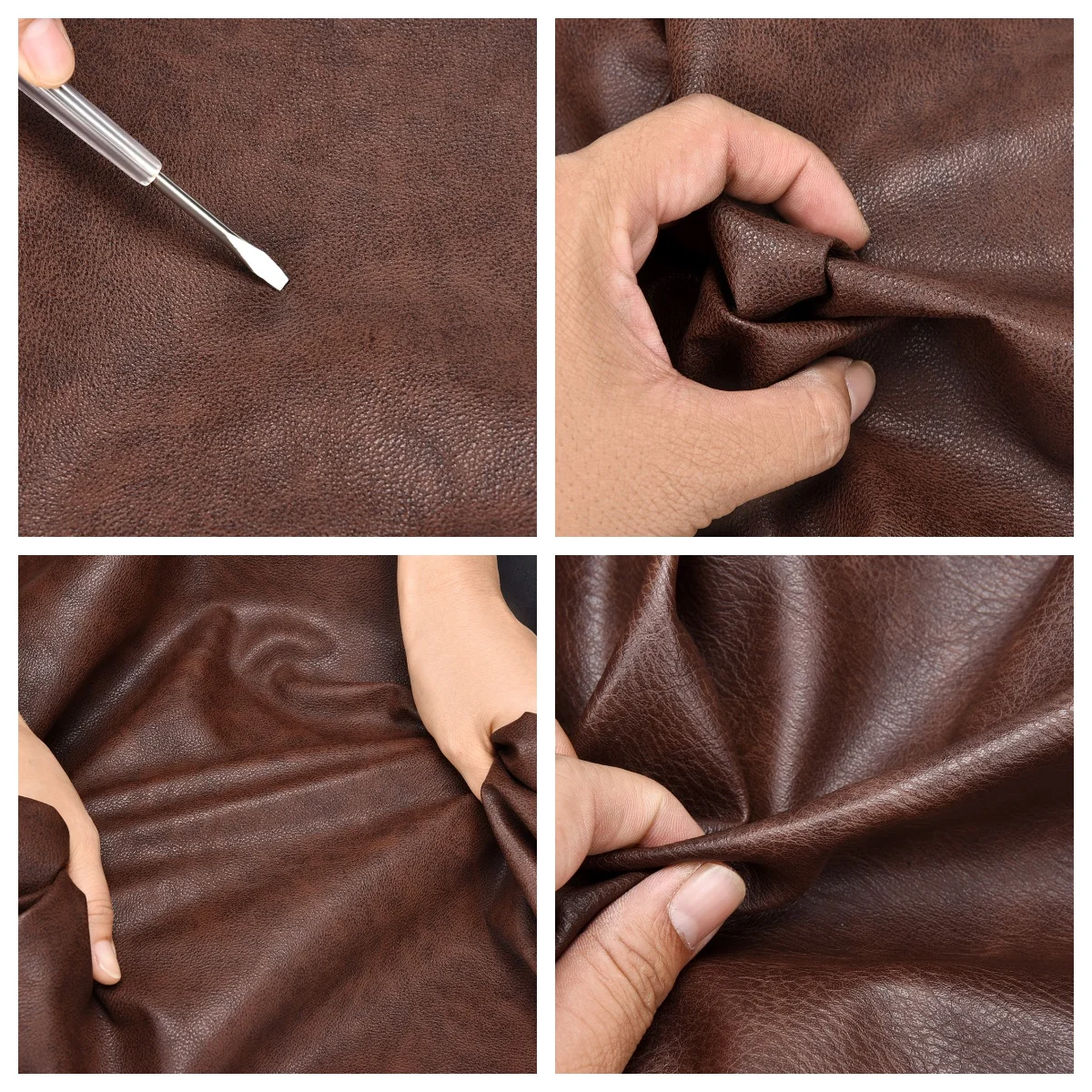
When shopping for leather backpacks of any grade, understanding what “genuine leather” truly represents helps you make more informed decisions about value versus initial cost.
Bonded Leather: The Lowest Grade of Real Leather
Bonded leather represents the lowest tier of products that can still legally be called “leather.” Understanding its composition helps explain why it’s generally unsuitable for quality backpacks.
Bonded leather is manufactured by shredding leather scraps and fiber leftovers, then mixing these with adhesives and binding them onto a fiber backing. This mixture is then embossed with a leather-like pattern and coated with finishes. Think of it as the “particle board” of leather—technically containing leather, but structurally very different from solid pieces.
Limited Advantages:
- Very low cost ($50-90 range for backpacks)
- Technically contains some leather material
- Uniform appearance without natural variations
- Can be produced in virtually any color
Major Limitations:
- Extremely poor durability, often failing within months of regular use
- Highly prone to peeling, cracking, and surface damage
- No breathability due to plastic coatings
- Lacks all structural benefits of higher-grade leathers
- Typically deceptive marketing suggesting higher quality than delivered
- Often mistaken for higher grades by uninformed consumers
Bonded leather should generally be avoided for items that will see regular use or that need to last beyond a season. Its primary purpose in the market is to provide a leather-like appearance at the lowest possible price point, but the trade-off in quality and durability is severe.
For backpack shoppers on tight budgets, better alternatives exist in either quality synthetic options or by investing in second-hand top-grain or full-grain leather backpacks.
Faux Leather Options: Synthetic Alternatives to Consider
Synthetic leather alternatives (often called “faux leather,” “vegan leather,” or “PU leather”) offer non-animal options that mimic the appearance of leather to varying degrees. These materials have improved significantly in recent years, making them worthy of consideration.
Common Types of Synthetic Leather:
- Polyurethane (PU) leather: A plastic coating applied to a fabric base
- Polyvinyl chloride (PVC): A plastic material often used in lower-cost synthetics
- Bio-based alternatives: Newer options made from plant sources like pineapple leaves, mushrooms, or apple peels
Advantages:
- Animal-free composition appeals to vegan consumers
- Lower cost ($40-120 range for backpacks)
- Consistent appearance without natural variations
- Lighter weight than genuine leather
- Often highly water-resistant
- Available in unlimited colors and patterns
- Minimal maintenance requirements
Limitations:
- Very limited lifespan (typically 1-2 years with regular use)
- Prone to cracking, peeling, and surface degradation
- Poor breathability leads to interior moisture issues
- Many types pose environmental concerns in production and disposal
- Cannot be repaired effectively once damaged
- Lacks the developing character and patina of real leather
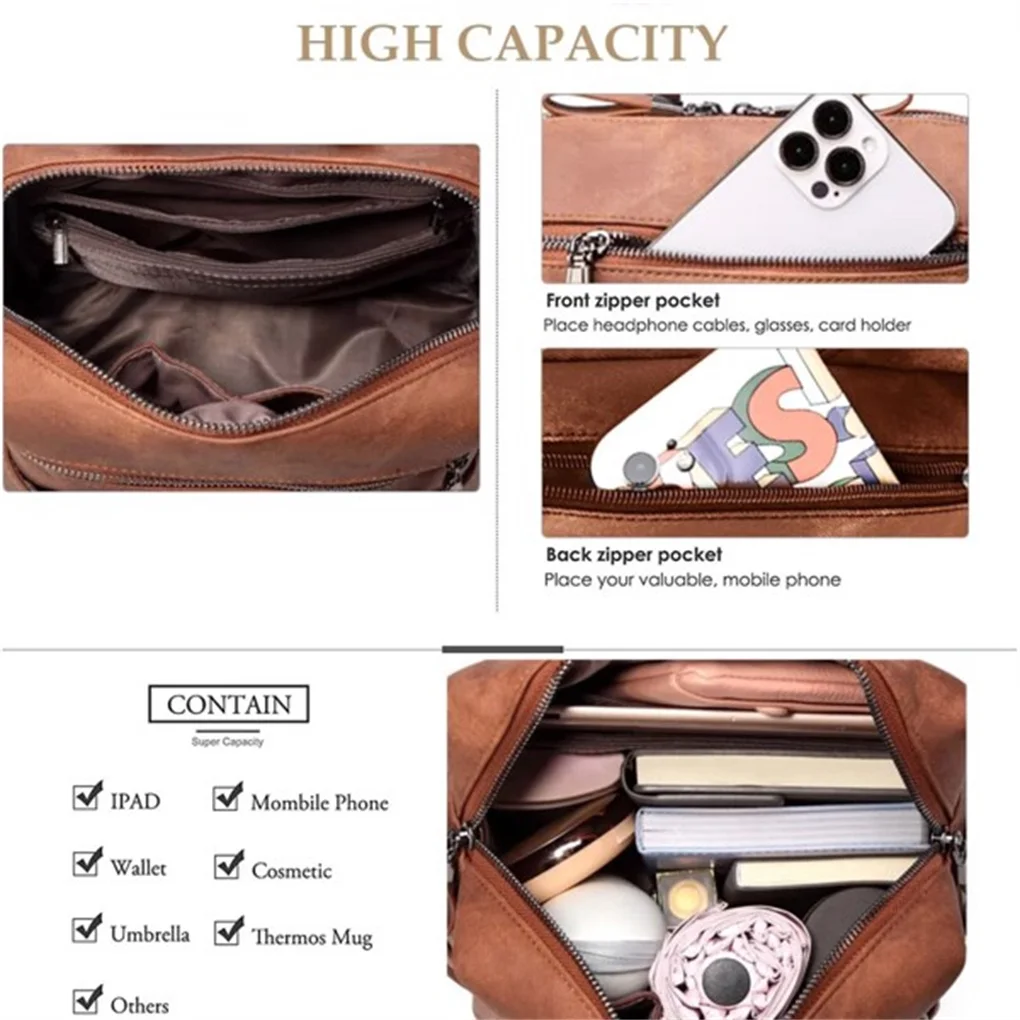
Faux leather backpacks are best suited for those who avoid animal products, shoppers with strict budget limitations, or those who prefer to follow fashion trends with frequently replaced items. Our women’s leather backpack collection includes options in various materials to accommodate different preferences and priorities.
Comparative Analysis: Which Leather Matches Your Needs?
To help you make an informed decision based on your specific priorities, this comprehensive comparison highlights key differences between leather types:
| Characteristic | Full-Grain | Top-Grain | Genuine | Bonded | Synthetic |
|---|---|---|---|---|---|
| Durability | 15-20+ years | 5-10 years | 1-3 years | 6-12 months | 1-2 years |
| Patina Development | Excellent | Moderate | Minimal | None | None |
| Maintenance Needs | Moderate | Low-Moderate | Low | None (disposable) | Very Low |
| Price Range | $200-400+ | $150-300 | $80-150 | $50-90 | $40-120 |
| Water Resistance | Naturally resistant | Good (treated) | Fair | Poor | Excellent initially |
| Weight | Heaviest | Moderately heavy | Medium | Light | Lightest |
| Breathability | Excellent | Good | Fair | Poor | Very poor |
| Environmental Impact | Long lifespan offsets impact | Good longevity | Short lifespan | Very poor | Varies by material |
When interpreting this information, consider your priorities. If longevity is paramount, the higher initial investment in full-grain or top-grain leather provides superior value over time. For example, a $300 full-grain backpack that lasts 15 years costs approximately $20 per year of use—significantly less than replacing a $90 bonded leather bag every year.
Your lifestyle and intended use should heavily influence your choice. Choosing the right leather quality for bags depends on factors like frequency of use, carrying environment, and personal style preferences.
Beyond Leather Type: Critical Features for Quality Backpacks
While leather type is foundational to backpack quality, several other construction elements significantly impact durability and function:
Stitching Quality
The strongest backpacks feature saddle stitching (two needles working from opposite sides) at stress points, though quality machine stitching with high thread count and bonded nylon thread also performs well. Look for tight, even stitches with no loose threads or skipped sections.
Hardware Components
Quality metal hardware dramatically outlasts plastic alternatives:
– Solid brass or nickel-plated brass zippers resist corrosion and operate smoothly
– Die-cast metal buckles and D-rings withstand tension without deforming
– YKK or similar premium zippers prevent the frustration of failure at inopportune moments
Reinforcement Points
Examine how straps attach to the bag body—reinforced attachment points with backing patches and multiple rows of stitching prevent tearing under load. Rivet reinforcement at corners and stress points adds years to a backpack’s lifespan.
Internal Structure
Quality backpacks feature:
– Durable cotton or synthetic lining that resists tearing
– Reinforced compartment dividers
– Structured backing to maintain shape
Ergonomic Design
Even the finest leather won’t compensate for poor design:
– Contoured straps that distribute weight comfortably
– Strategic padding that prevents pressure points
– Balanced weight distribution when loaded
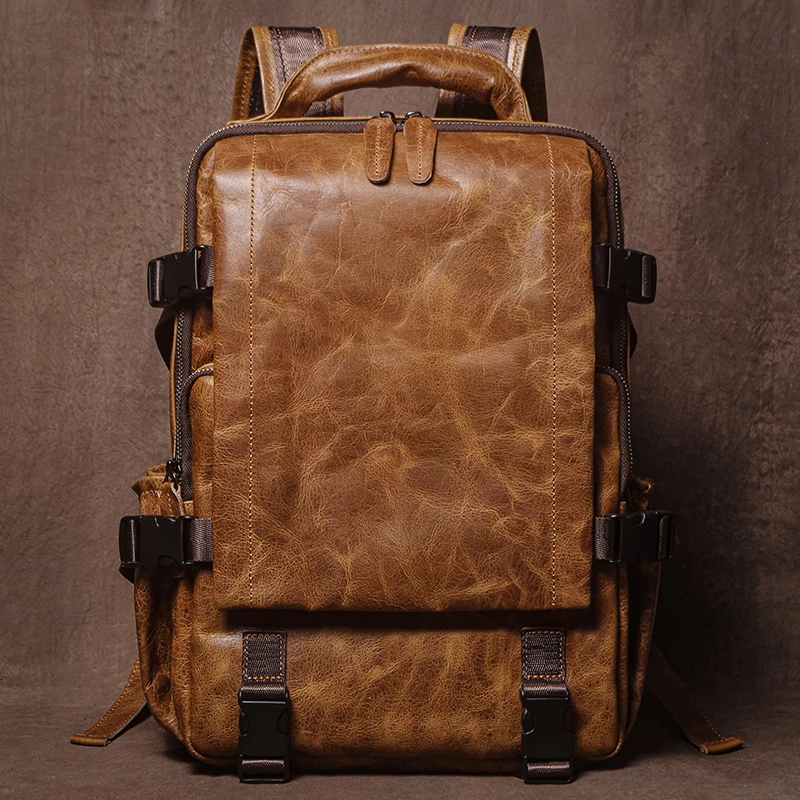
Our leather laptop backpacks showcase how quality construction complements premium materials to create products that excel in both function and longevity.
Matching Leather Type to Your Use Case
Different lifestyles and usage patterns call for specific leather types that best balance durability, appearance, and value:
Daily Commuters
For those using their backpack every day in urban environments, full-grain or top-grain leather provides the best balance. The daily wear demands durability, while the professional setting benefits from refined appearance. Top-grain offers a slightly lighter weight for comfortable daily carry, while full-grain provides maximum longevity.
Frequent Travelers
Travel puts exceptional stress on bags. Full-grain leather’s superior durability makes it ideal for frequent travelers, particularly when reinforced with quality hardware and water-resistant treatment. The natural security of thick leather also helps protect valuables during transit.
Students
Students typically balance budget constraints with the need for reasonable durability. Top-grain leather offers a good compromise, lasting through several years of education. Those on tighter budgets might consider quality synthetic options with the understanding they’ll likely need replacement sooner.
Professionals
Business environments call for bags that convey professionalism while organizing essentials. Top-grain leather often provides the ideal balance of refined appearance and good durability, with less maintenance than full-grain options. Consider how different leather types influence durability in bags when selecting a professional companion.
Outdoor Enthusiasts
For those using backpacks in outdoor settings, the optimal leather thickness for backpacks becomes especially important. Full-grain leather with appropriate water-resistant treatment stands up best to variable conditions, though dedicated outdoor activities might be better served by technical synthetic materials designed specifically for those environments.
14 Inch Leather Laptop Backpack, Brown Leather Backpack, Men's Leather Backpack, Vintage Leather Backpack
Price range: $177.28 through $199.12 Select options This product has multiple variants. The options may be chosen on the product pageCarry On Leather Backpack, Roll Top Leather Backpack
Price range: $77.76 through $96.48 Select options This product has multiple variants. The options may be chosen on the product pageDesigner Men's Backpack, Men's Leather Laptop Backpack, Men's Leather Work Backpack
Price range: $158.04 through $160.04 Select options This product has multiple variants. The options may be chosen on the product pageDesigner Mini Backpack, Mini Leather Backpack, Small Leather Sling Backpack, Women's Leather Backpack
Price range: $95.76 through $98.80 Select options This product has multiple variants. The options may be chosen on the product pageDesigner Mini Backpack, Designer Women's Backpack, Mini Leather Backpack, Women's Leather Backpack
Price range: $135.92 through $137.64 Select options This product has multiple variants. The options may be chosen on the product page15 Inch Leather Laptop Backpack, Leather Briefcase Backpack
$332.96 Select options This product has multiple variants. The options may be chosen on the product page
Essential Care Tips for Extending Your Leather Backpack’s Life
Proper maintenance dramatically extends the lifespan of any leather backpack. These fundamental care practices help protect your investment:
Regular Cleaning
Remove surface dirt and dust with a soft cloth before it becomes embedded. For fuller cleaning, use leather-specific cleaners appropriate to your leather type, avoiding household soaps that can dry out the material.Conditioning
Apply quality leather conditioner every 3-6 months (more in dry climates) to replace natural oils that prevent cracking. Full-grain and top-grain leathers particularly benefit from regular conditioning to maintain suppleness.Water Protection
Apply appropriate leather protectant to create a barrier against moisture. Even water-resistant leathers benefit from periodic reapplication of protectant, especially before rainy seasons.Proper Storage
Store your backpack stuffed with acid-free tissue to maintain shape, away from direct sunlight and extreme temperatures. Never store leather in plastic bags, which can trap moisture and lead to mildew.Addressing Issues Promptly
Small scratches in full-grain and top-grain leather can often be buffed out with a soft cloth. Minor stains should be addressed quickly using appropriate leather cleaners before they set permanently.
For more detailed information on maintaining your investment, our guide on how to clean leather backpacks provides comprehensive care instructions specific to different leather types.
Common Misconceptions About Leather Backpacks
Myth: “Genuine Leather” Means High Quality
Reality: “Genuine Leather” is actually a specific grade indicating lower-quality split leather, not a verification of authenticity. Full-grain and top-grain leathers represent much higher quality standards.
Myth: Leather Backpacks Are Completely Waterproof
Reality: While quality leather offers natural water resistance, no untreated leather is truly waterproof. Even with protective treatment, extended exposure to heavy rain will eventually allow moisture penetration.
Myth: Heavier Always Means Better Quality
Reality: While quality leather has natural weight, artificially weighted lower-grade leathers exist. Weight should be evaluated alongside other quality indicators like grain pattern and flexibility.
Myth: Leather Requires Complicated Maintenance
Reality: Quality leather needs simple but consistent care—regular dusting, occasional conditioning, and prompt attention to spills. This basic maintenance is straightforward but essential.
Myth: Price Always Indicates Quality
Reality: While better leather generally costs more, brand premiums don’t always reflect material quality. Understanding leather grades helps identify true value regardless of price point.
Is Full-Grain Leather Always Worth the Premium Price?
While full-grain leather represents the pinnacle of quality, its higher price isn’t always necessary for every user. This premium investment makes the most sense when:
- You plan to use your backpack daily for many years
- You appreciate the developing character and patina of natural leather aging
- Your usage involves significant stress on the bag
- You value the ability to repair rather than replace
- The aesthetic of natural leather with visible character matters to you
However, top-grain leather offers a compelling alternative when:
– A more consistent, refined appearance is preferred
– Weight is a significant consideration
– Your expected usage is moderate rather than intense
– Your budget prioritizes balance between quality and cost
The disadvantages of full-grain leather, such as higher initial cost and maintenance needs, should be weighed against its exceptional longevity. For many users, the lifetime value calculation strongly favors full-grain despite higher upfront costs.
Are Vegan Leather Alternatives Getting Better?
The quality of synthetic leather alternatives has improved substantially in recent years, driven by both technological advances and increasing consumer demand for non-animal products:
Modern polyurethane (PU) leathers have become more durable and flexible than earlier generations, with better resistance to cracking and peeling. More exciting are the innovations in plant-based alternatives like Piñatex (pineapple leaf fiber), mushroom leather (mycelium), and apple leather (made from fruit industry waste).
These newer alternatives offer environmental benefits beyond animal welfare, often utilizing agricultural byproducts and requiring fewer toxic chemicals in production. However, most still have significant limitations compared to animal leather:
- Durability remains substantially shorter (typically 1-3 years vs. 5-20+ for quality animal leather)
- The breathability gap persists, with most synthetics trapping moisture
- Repair options are limited or impossible with most synthetic materials
- The unique patina development of animal leather cannot be replicated
For those committed to vegan materials, these improving alternatives represent welcome progress, though the quality gap remains substantial for now.
How Can You Verify Leather Quality Before Purchasing?
Identifying quality leather requires looking beyond marketing terminology to evaluate the material itself:
Visual Inspection
- Edge Examination: Look at cut edges—high-quality leather shows consistent coloring throughout its thickness, while lower grades may show a colored surface over a different interior.
- Grain Pattern: Full-grain and top-grain leathers display natural variations in the grain pattern. Too-perfect patterns often indicate embossed corrections on lower grades.
- Surface Texture: Quality leather has subtle variations in texture; perfectly smooth surfaces often indicate heavy finishing on lower grades.
Touch Tests
- Flexibility: Quality leather feels supple and becomes more flexible when handled. Stiff, plastic-like feel often indicates heavy synthetic coating.
- Temperature Response: Real leather quickly warms to your touch, while synthetics remain cool longer.
- Texture Consistency: Run your fingers across the surface—natural leather has subtle texture variations that you can feel.
Aroma Test
Higher-grade leathers have a distinctive natural smell. Chemical or plastic odors suggest lower-quality materials or heavy synthetic treatments. Understanding whether 100% leather means full-grain helps you interpret product descriptions more accurately.
By combining these verification methods with knowledge of leather grades, you can make informed decisions that align with your priorities for durability, appearance, and value.

